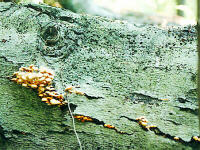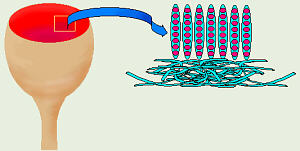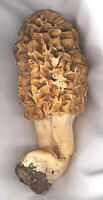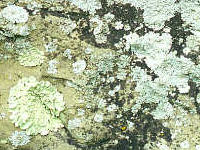
Saprophytic Mushrooms in Log Saprophytes absorb nutrients from dead organic matter (dung, corpses, etc.). These are important, necessary decomposers.
Fungi are eukaryotes and are heterotrophs that absorb (not ingest) their food. They secrete digestive chemicals into their environment, where the food is “digested”, after which they absorb the nutrients. Most fungi are multicellular (yeast are secondarily unicellular). Fungi can be saprophytes, parasites, or mutualistic symbionts.

Saprophytic Mushrooms in Log
Saprophytes
absorb nutrients from dead organic matter (dung, corpses, etc.). These are
important, necessary decomposers.
Parasites absorb nutrients from the body fluids of a host organism, to the detriment of the host.
Mutualistic symbionts absorb nutrients from a host, but reciprocate with some beneficial function(s). For example, mycorrhiza (-ae) (rhizo = root) are special fungi that live in/on the roots of plants, especially trees. This mutualistic association of plant roots and fungi is beneficial to both organisms because, through their digestive enzymes, the fungi help make minerals available to the plant and help in water absorption (they are smaller diameter than any of the tree roots) in return for organic “food” from the plant. About 90% of all trees depend on micorrhizae and bare-root trees often don’t do as well because all of the smaller roots where the micorrhizal fungi would normally live are pruned off. I have seen suggestions in various gardening books that when bare-root trees are planted, a couple shovel-fuls of forest soil should be put around their roots to inoculate them with the necessary fungi.
The “body” of a fungus is called a mycelium (pl = mycelia) (myce = fungus). A mycelium is a tangled network of filaments, each of which is called a hypha (pl. = hyphae; hypha = web, weaving). Some species of fungi have their hyphae divided into individual cells while others have hyphae that are multinucleate tubes without individual cells. Growth of a mycelium (the hyphae therein) can be very rapid, hence mushrooms (which are composed of densly-packed hyphae) can pop up in a lawn overnight.
The normal condition for fungal nuclei is 1n, and mitosis happens slightly differently than in other groups of eukaryotes. “Normal” fungal reproduction is asexual by just making spores that are disseminated by wind or water. However, especially under adverse conditions, many fungi also have some form of sexual reproduction with the formation of a different kind of spores, and fungi are grouped/classified based on what type of sexual reproduction they use.

Fankhauser Blue Cheese
A number of fungi are commercially important: yeast and all the various
edible mushrooms are fungi; blue, Roquefort, Camembert, and Brie cheeses are
made using Penicillium roqueforti or Penicillium camemberti;
and P. notatum is the source of penicillin. A variety of other molds
are used for drugs, cheeses, etc.; other edible mushrooms are used in
Oriental cooking; some mushrooms like truffles, puffballs, morels are
considered to be delicacies: and various strains of the yeast,
Saccharomyces cerevisiae, are used for beer, wine, and bread.
On the other hand, a number of fungi are pathogenic and adversely affect humans. Some mushrooms are toxic so you should never eat wild mushrooms unless you are absolutely, positively sure what they are. Ergot of rye grows in rye and if infected rye is milled into flour and ingested, people who eat that flour will ingest the chemical ergotine, which is both toxic and hallucinogenic (and also contains lysergic acid from which LSD is made). Ergotine can cause spasms and a burning sensation. Currently, ergotine is used in very small (dilute) amounts to stop postpartum bleeding.
Candida albicans is normally a a single-celled, yeast-type fungus which lives in our large intestines. Normally, it is a small part of the intestinal flora and is kept in check by the good bacteria that live in our colons. If for some reason it becomes necessary for a person to take antibiotics, as we previously discussed, these antibiotics will kill the good bacteria, allowing Candida and other such invaders to multiply. Also, if the person eats too much sugar or other simple carbohydrates, these will serve as food for the Candida, helping it to multiply, grow, and/or travel to other parts of the body, where it is called “vaginal yeast infection” (both partners must be treated simultaneously or they’ll just pass it back and forth) or “thrush” (if it’s in someone’s mouth and/or throat). There is also some evidence that Candida can turn into a mycelium with hyphae invading body tissues. To help fight against a “yeast” infection, a number of people have suggested eating yogurt daily, especially if a person is on antibiotics, and I read, somewhere, that women who consume a cup of yogurt a day have less problems with “yeast” infections. If a person has a number of bacterial infections, and antibiotics are frequently prescribed and/or if a person is prone to “yeast” infections, that person should insist that his/her doctor prescribe a fungicide (nystatin, which goes by brand names like Mycostatin, or Nilstat, Nystex, etc.) along with any antibiotics that are prescribed. From what I’ve read, it is strongly suggested that such a person also avoid foods either naturally or artificially high in sugar and simple carbohydrates (grapes, bananas, pop, candy, cookies, etc. white flour, white rice) which just serve as food for the Candida, making things worse. Rather, this person should replace these with a high fiber, adequate protein diet. There is also evidence that taking garlic on a daily basis helps — garlic is a known fungicide. I have heard that some people put yogurt on an infected site and that some women use a yogurt douche, but it would probably be a good idea to discuss these options with your physician first. It is important to keep the infected area as dry as possible, and open to fresh air if possible. If the site is normally covered by clothing, wear cotton clothing because polyester holds in body moisture — women with vaginal yeast infections shouldn’t wear nylons.







